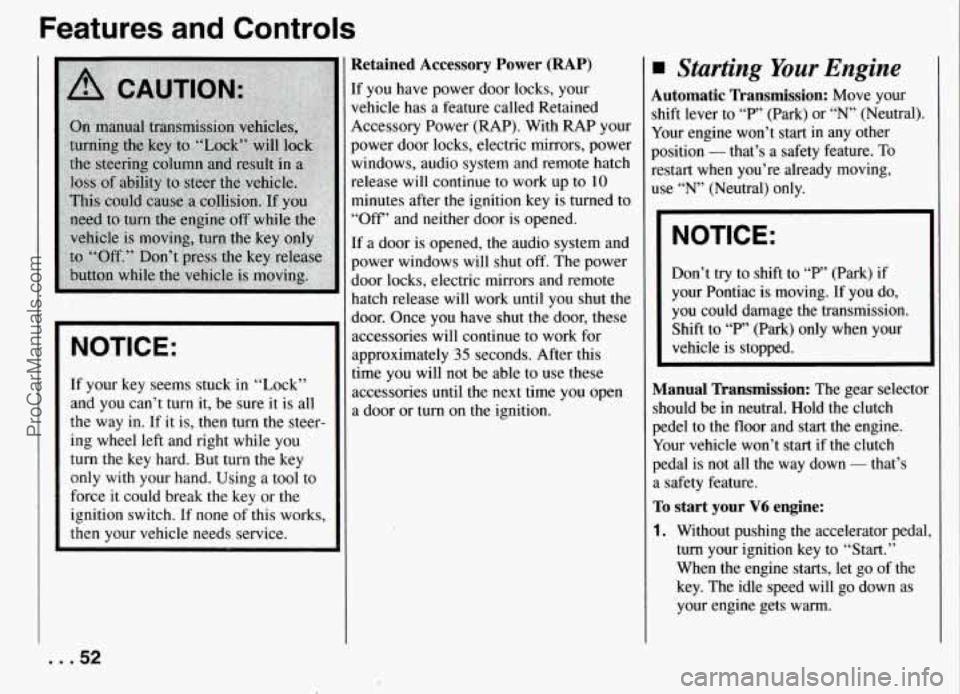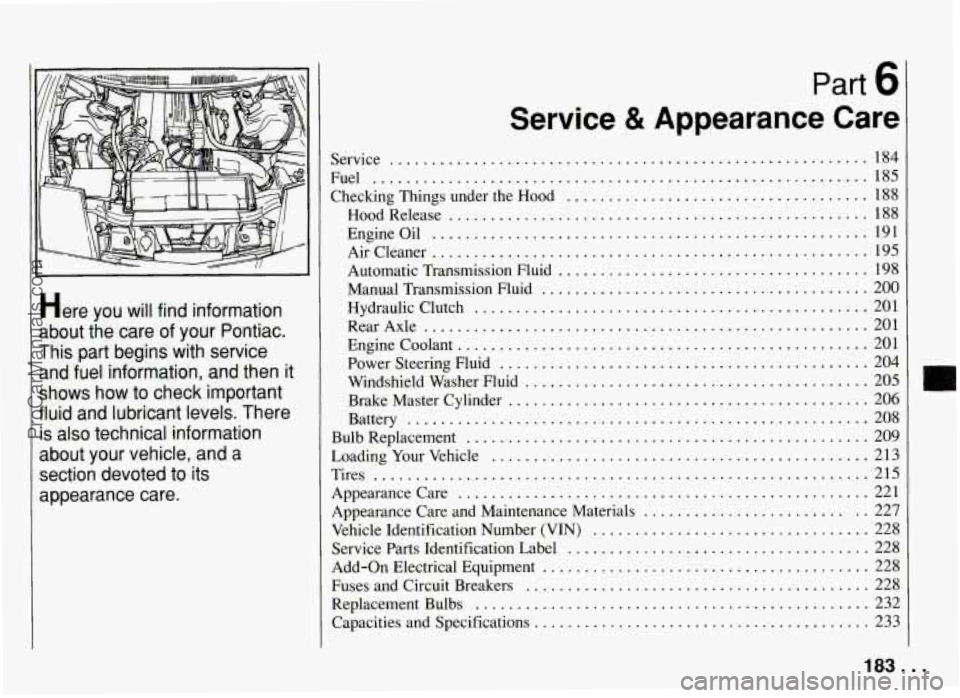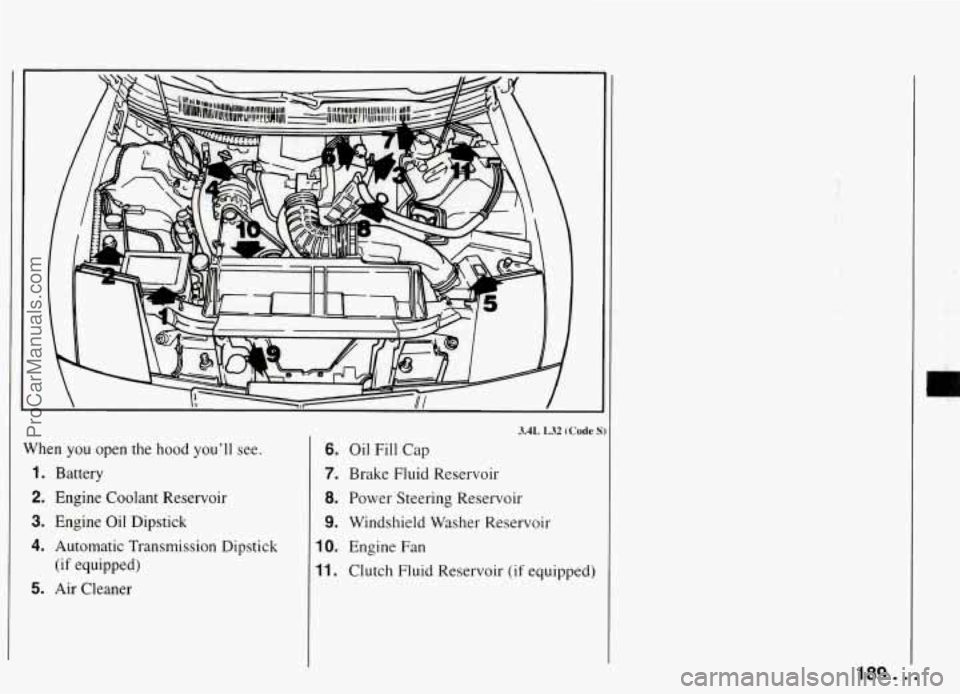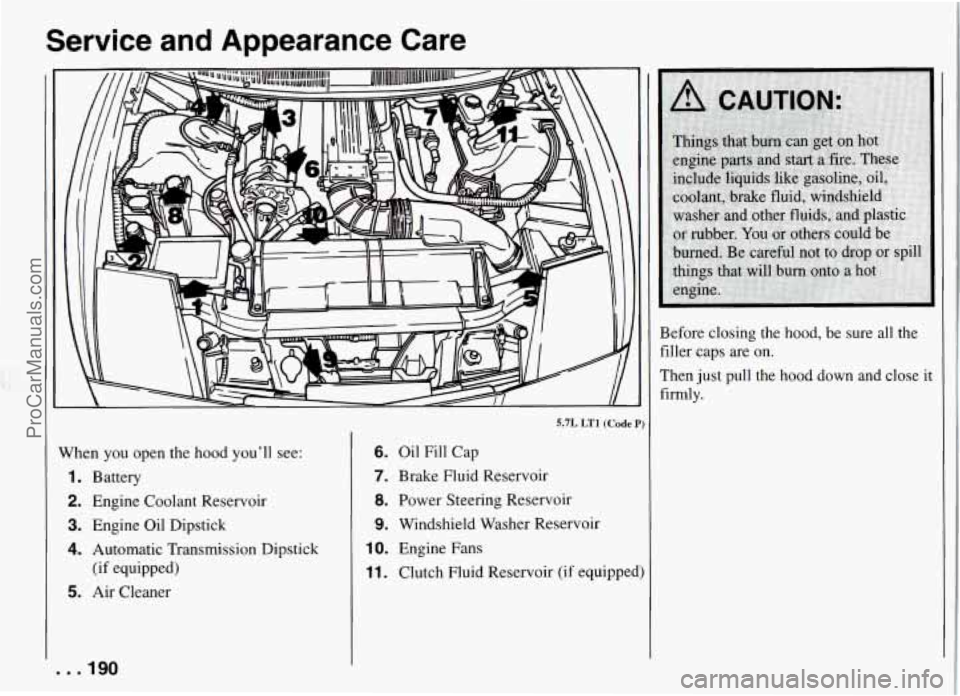clutch PONTIAC FIREBIRD 1994 Owners Manual
[x] Cancel search | Manufacturer: PONTIAC, Model Year: 1994, Model line: FIREBIRD, Model: PONTIAC FIREBIRD 1994Pages: 290, PDF Size: 14.84 MB
Page 53 of 290

Features and Controls
If your key seems stuck in “Lock”
and you can’t turn it, be sure it is all
the way in. If
it is, then turn the steer-
ing wheel left and right while you
turn the key hard. But turn the key
only with your hand. Using a tool to
force it could break the key or the
ignition switch.
If none of this works,
then your vehicle needs service.
Retained Accessory Power (RAP)
[f you have power door locks, your
vehicle has a feature called Retained
Accessory Power (RAP). With
RAP your
power door locks, electric mirrors, power
windows, audio system and remote hatch
release will continue to work up to 10
minutes after the ignition key is turned to
“OW’ and neither door is opened.
[f a door is opened, the audio system and
power windows will shut
off. The power
door locks, electric mirrors and remote
hatch release will work until you shut the
door. Once you have shut the door, these
accessories will continue to work for
approximately
35 seconds. After this
time you will not be able to use these
accessories until the next time you open
a door or turn on the ignition.
Starting Your Engine
Automatic Transmission: Move your
shift lever to
“P” (Park) or “N’ (Neutral).
Your engine won’t start in any other
position
- that’s a safety feature. To
restart when you’re already moving,
use
“N’ (Neutral) only.
NOTICE:
Don’t try to shift to “P” (Park) if
your Pontiac is moving. If you do,
you could damage the transmission.
Shift to
“P” (Park) only when your
vehicle is stopped.
Manual Transmission: The gear select01
should be in neutral. Hold the clutch
pede1 to the floor and start the engine.
Your vehicle won’t start if the clutch
pedal is not all the way down
- that’s
a safety feature.
To start your V6 engine:
1. Without pushing the accelerator pedal
turn your ignition key to “Start.”
When the engine starts, let go of the
key. The idle speed will go down as
your engine gets warm.
... 52
ProCarManuals.com
Page 60 of 290

1 3 5
2
4 R
Manual Transmission
We-Speed
’his is your shift pattern. Here’s how to
perate your transmission:
1 1 (First Gear) - Press the clutch
pedal and shift into
“ 1 .” Then, slowly
let up on the clutch pedal as you
press the accelerator pedal.
You can shift into
“1” when you’re
going less than
20 mph (32 km/h). If
you’ve come to a complete stop and
it’s hard to shift into
“1,” put the shift
lever in “Neutral” and let up on the
clutch. Press the clutch pedal back
down. Then shift into
“1.”
2 (Second Gear) - Press the clutch
pedal as you let up on the accelerator
pedal and shift into
“2.” Then, slowly
let up
on the clutch pedal as you
press the accelerator pedal.
3,4 and 5 (Third, Fourth and Fifth
Gears)
- Shift into “3,” “4” and “5”
the same way you do for “2.” Slowly
let up on the clutch pedal as you press
the accelerator pedal.
To Stop - Let up on the accelerator
pedal and press the brake pedal. Just
before the vehicle stops, press the
clutch pedal and the brake pedal, and
shift to “Neutral.”
Neutral - Use this position when
you start or idle your engine.
R (Reverse) - To back up, press
down
the clutch pedal and shift into
“R.” Let up on the clutch pedal slowly
while pressing
the accelerator pedal.
I NOTICE:
Shift to “R” (Reverse) only after
your vehicle
is stopped. Shifting to
“R” (Reverse) while your vehicle
is moving could damage your
transmission.
Also, use Reverse, along with the parking
brake, for parking your vehicle.
11.. I. *i
59 ... ProCarManuals.com
Page 61 of 290

Features and Controls
Six-Speed ,-
This is your shift pattern. Here’s how to
operate your transmission:
0 1 (First Gear) - Press the clutch
pedal and shift into
“1.” Then, slowly
let up on the clutch pedal as you
press the accelerator pedal.
You can shift into “1” when you’re
going less than
20 mph (30 km/h). If
you’ve come to a complete stop and
it’s hard to shift into
“1,” put the shift
lever in “Neutral” and let up on
the
clutch. Press the clutch pedal back
down. Then shift into
“1.”
2 (Second Gear) - Press the clutch
pedal as you let up on the accelerator
pedal and shift into
“2.” Then, slowly
let up
on the clutch pedal as you
press the accelerator pedal.
3,4,5 and 6 (Third, Fourth, Fifth
and
Sixth Gears) - Shift into “3,”
“4,” “5” and “6” the same way you do
for
“2.” Slowly let up on the clutch
pedal as
you press the accelerator
pedal.
To Stop - Let up on the accelerator
pedal and press the brake pedal. Just
before the vehicle stops, press the
clutch pedal and the brake pedal,
and shift to “Neutral.”
Neutral - Use this position when
you start or idle your engine.
R (Reverse) - To back up, press
down the clutch pedal and shift into
“R.” Let up on the clutch pedal slowly
while pressing the accelerator pedal.
. . .60
ProCarManuals.com
Page 62 of 290

Your six-speed manual transmission
has a feature that allows you to safely
shift into
“R’ (Reverse) while the vehicle
is rolling (at less than 3 mph). You will be
“locked-out” if you try to shift into “R”
(Reverse) while your vehicle is’ moving
faster than
3 mph.
If you have turned your ignition off and
wish to park your vehicle in Reverse, you
will have to move the shift lever quickly
to the right, “crashing” through the high
load spring and then into gear.
SKIP
SHIFT
;kip Shift Light (5.7L LT1 Engine)
Yhen this light comes on, you can only
hift from
“1” (First) to “4” (Fourth) gear
nstead of “1” (First) to “2” (Second)
gar. This helps you to get
the best
lossible fuel economy.
’his light will come on under these
onditions:
The engine coolant temperature is greater than 170°F (77”C),
You are going
15-20 mph
(24-32
km/h), and
You are
at 35% throttle or less. When this
light
is on, the gear shift lever
will let you shift from
“1” (First) gear to
“4”(Fourth) gears only. Once you are
in
“4” (Fourth) gear, you can press the
clutch again and shift into another gear.
Follow the shift speeds in this chart when
the
“SKIP SHIFT” light is on.
Computer Aided Manual Transmission
Shift Speeds:
1st to 4th. . , . , . . 15 mph (24 km/h)
4th to 5th ...... 25 mph (40 km/h)*
5th
to 6th ...... 40 mph (64 km/h)**
Each time you come to
a stop, the
engine’s Electronic Control Module
(EGM) determines when to activate the
“SKIP SHIFT” upshift system. Use
“2”
(Second) gear only when you accelerate
very quickly from’a stop.
You can then
follow the full gear shift pattern.
*30 mph (48 km/h) when accelerating
to highway speeds.
**45 mph (72 km/h) when accelerating
to highway
speeds.
61 ’. , . ProCarManuals.com
Page 63 of 290

Features and Controls
shift Speeds (MANUAL TRANSMISSION)
This chart shows when to shift to the next higher gear for best fuel economy.
MANUAL TRANSMISSION RECOMMENDED SHIFT SPEEDS, IN MPH (km/h)
Acceleration Shift Speed
1 to2 5
to
6 4 to 5 3 to 4 2 to 3
Engine
3.4L L32
you should downshift to the next lower gear. You may have to downshift two or more
If
your speed drops below
20 mph (30 km/h), or if the engine is not running smoothly,
(80)
(72)
(64)
(40)
(24)
(Code P)
50 45 40
25 15 5.7L LTI NIA
(72-75)
(51-59)
(34-35)
(21-25)
(Code
S)
45-47
32-37
21 -28
13-1 6
gears to keep the engine running smoothly or for
good performance.
NOTICE:
If you skip more than one gear when
you downshift, or if you race the
engine when you downshift, you can
damage the clutch or transmission.
Limited-Slip Rear Axle
If you have this feature, your rear axle
can give you additional traction on
snow, mud, ice, sand or gravel. It works
like a standard axle most of the time,
but
when one of the rear wheels has
no traction and the other does, the limited-slip feature will allow the
wheel with traction to move the vehicle.
... 62
ProCarManuals.com
Page 76 of 290

Passing Another Vehicle While Using
Cruise Control
Use the accelerator pedal to increase your
speed. When you take your foot
off the
pedal, your vehicle will slow down to the
Cruise Control speed you set earlier.
Using Cruise Control on Hills
How well your Cruise Control will work
on hills depends upon your speed, load,
and the steepness
of the hills. When going
up steep hills, you may have to step on
the accelerator pedal to maintain your
speed. When going downhill, you may
have to brake or
shift to a lower gear to
keep your speed down.
Of course,
applying the brake takes you out
of
Cruise Control. Many drivers find this to
be too much trouble and don’t use Cruise
Control on steep hills.
ro Get Out of Cruise Control
:here are several ways to turn off the
3ruise Control:
I. Step lightly on the brake pedal or pus1
the clutch pedal, if you have a manual
transmission;
OR
!. Move the Cruise switch to “OFF.”
:o Erase Speed Memory
Yhen you turn off the Cruise Control or
he ignition, your Cruise Control set speec
nemory is erased.
kaction Control System and Cruise
lontrol
f your traction control system engages
vhile your Cruise Control
is set, Cruise
lontrol will disengage. Your speed will
le
set in memory, though. When Cruise
lontrol engages again, use
“WA”
Resume/Accelerate) to go back to your
et speed.
”‘ 1. 2. 4>
fa...
ProCarManuals.com
Page 184 of 290

I I
Here you will find information
about the care of your Pontiac
.
This part begins with service and fuel information. and then
it
shows how to check important
fluid and lubricant levels
. There
is also technical information
about your vehicle. and a section devoted
to its
appearance care
.
Part b
Service 8t Appearance Care
Service .........................................................
Fuel ...........................................................
Checking Things under the Hood ....................................
HoodRelease ..................................................
184
185
188
188
Engineoil
.................................................... 191
Aircleaner
.................................................... 195
Automatic Transmission Fluid
..................................... 198
Manual Transmission Fluid
....................................... 200
Hydraulic Clutch
............................................... 201
RearAxle
..................................................... 201
Enginecoolant
................................................. 201
Power Steering fluid
............................................ 204
Windshield Washer Fluid
......................................... 205
Brake Master Cylinder
........................................... 206
Bulb Replacement
................................................ 209
Battery
....................................................... 208
LoadingYourVehicle
............................................. 213
Tires
........................................................... 215
Appearance Care
................................................. 221
Appearance Care and Maintenance Materials
.......................... 227
Vehicle Identification Number (VIN)
................................. 228
Service Parts Identification Label
.................................... 228
Add-on Electrical Equipment
....................................... 228
Fuses and Circuit Breakers
......................................... 228
ReplacementBulbs
............................................... 232
Capacities and Specifications
........................................ 233
183 ...
ProCarManuals.com
Page 190 of 290

3.4L L32 (Code !
When you open the hood you'll see.
1. Battery
2. Engine Coolant Reservoir
3. Engine Oil Dipstick
4. Automatic Transmission Dipstick
5. Air Cleaner (if equipped)
6. Oil Fill
Cap
7. Brake Fluid Reservoir
8. Power Steering Reservoir
9. Windshield Washer Reservoir
10. Engine Fan
11. Clutch Fluid Reservoir (if equipped)
B
189 ...
ProCarManuals.com
Page 191 of 290

Service and Appearance Care
5.7L LTl (Code
When you open the hood you'll see:
1. Battery
2. Engine Coolant Reservoir
3. Engine Oil Dipstick
4. Automatic Transmission Dipstick
5. Air Cleaner (if equipped)
6. Oil Fill
Cap
7. Brake Fluid Reservoir
8. Power Steering Reservoir
9. Windshield Washer Reservoir
IO. Engine Fans
11. Clutch Fluid Reservoir (if equippec Before closing the hood,
be sure all the
filler caps are on.
Then just pull the hood down and close it firmly.
-. .190
ProCarManuals.com
Page 202 of 290

Hydraulic Clutch
The hydraulic clutch in your vehicle is
self-adjusting. The clutch master cylinder
reservoir is filled with hydraulic clutch
fluid.
It isn’t a good idea to “top
off’ your
clutch fluid. Adding fluid won’t correct a
leak.
A fluid loss in this system could indicate
a problem. Have the system inspected and
repaired.
When to Check and What to Use:
Refer to the Maintenance Schedule to
determine how often you should check
the fluid level in your clutch master
cylinder reservoir and for the proper fluid.
See “Owner Checks and Services” and
“Recommended Fluids and Lubricants”
in the Index.
How to Check:
The proper fluid should be added if the
level
is below the “STEP’ mark on the
reservoir. See the instructions on the
reservoir cap.
Rear Axle
When to Check and Change Lubricant:
Refer to the Maintenance Schedule to
determine how often to check the
lubricant and when to change
it. See
“Periodic Maintenance Inspections” in
the Index.
How to Check Lubricant:
If the level is below the bottom of the
filler plug hole, you’ll need to add some
lubricant. Add enough lubricant to raise
the level to the bottom of the filler plug
hole.
What to Use
Standard Differential
Use Axle Lubricant (GM Part No.
1052271) or SAE 80W-90 GL-5 gear
lubricant.
Limited-Slip Differential
To add lubricant when the.leve1 is
low, use Axle Lubricant (GM Part
No.
105227 1) or SAE 8OW-90 GL-5 gear
lubricant. To completely refill after
draining, add
4 ounces ( 1 18 ml) of
Limited-Slip Differential Lubricant
Additive (GM
Part No. 1052358). Then
fill to the bottom of the filler plug hole
with Axle Lubricant (GM
Part No.
12345977) or SAE 8OW-90 GL-5 gear
lubricant.
Engine Coolant
The following explains your cooling system and how to add coolant when
it is low. If you have a problem with
engine overheating or if you need to add
coolant to your radiator, see “Engine Overheating” in the Index.
I
201 . . .
ProCarManuals.com